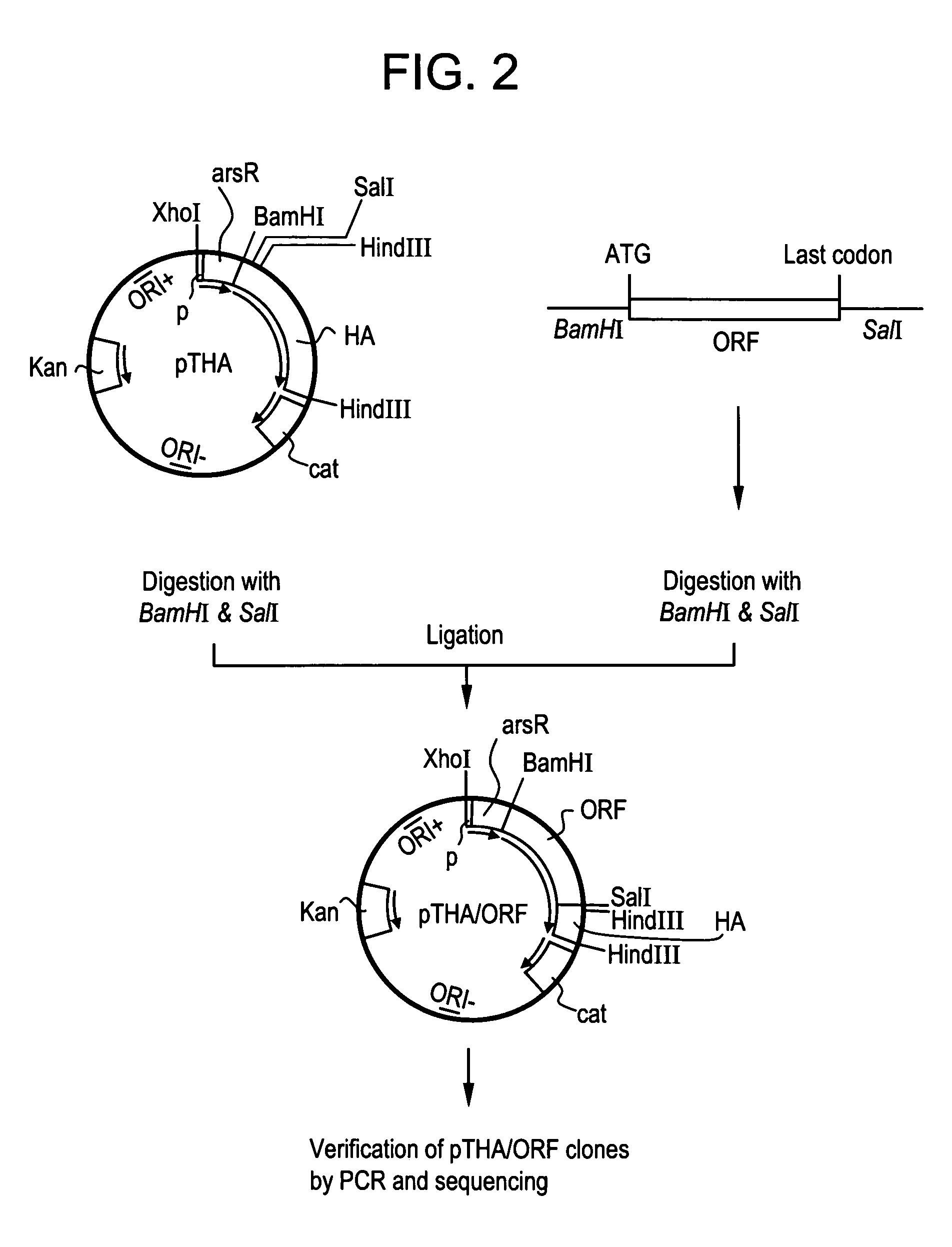DNA sequences from staphylococcus aureus bacteriophage 77 that encode anti-microbial polypeptides
a technology of anti-microbial polypeptides and sequences, which is applied in the direction of peptides, peptide/protein ingredients, peptide sources, etc., can solve the problems of epidemic proportions, morbidity, mortality and health-care costs, and certain infections that have become essentially untreatable and can not be treated
- Summary
- Abstract
- Description
- Claims
- Application Information
AI Technical Summary
Benefits of technology
Problems solved by technology
Method used
Image
Examples
example i
Growth of Staph A Bacteriophage 77 and Purification of Genomic DNA
[0156]The Staphylococcus aureus propagating strain (PS 77; ATCC #27699) was used as a host to propagate its respective phage 77 (ATCC # 27699-B1). Two rounds of plaque purification of phage 77 were performed on soft agar essentially as described in Sambrook et al (1989). Briefly, the PS 77 strain was grown overnight at 37° C. in Nutrient broth [NB: 0.3% Bacto beef extract, 0.5% Bacto peptone (Difco Laboratories) and 0.5% NaCl (w / v)]. The culture was then diluted 20× in NB and incubated at 37° C. until the OD540=0.2 (early log phase) with constant agitation. In order to obtain single plaques, phage 77 was subjected to 10-fold serial dilutions using phage buffer (1 mM MgSO4, 5 mM MgCl2, 80 mM NaCl and 0.1% Gelatin (w / v)) and 10 μl of each dilution was used to infect 0.5 ml of the cell suspension in the presence of 400 μg / ml CaCl2. After incubation of 15 min at room temperature (RT), 2 ml of melted soft agar kept at 45° ...
example ii
DNA Sequencing of Bacteriophage 77 Genome
[0158]Four micrograms of phage DNA was diluted in 200 μl of TE (10 mM Tris, [pH 8.0], 1 mM EDT A) in a 1.5 ml eppendorf tube and sonication was performed (550 Sonic Dismembrator™, Fisher Scientific). Samples were sonicated under an amplitude of 3 μm with bursts of 5 s spaced by 15 s cooling in ice / water for 3 to 4 cycles. The sonicated DNA was then size fractionated by electrophoresis on 1% agarose gels utilizing TAE (1×TAE is: 40 mM Tris-acetate, 1 mM EDTA [pH 8.0]) as the running buffer. Fractions ranging from 1 to 2 kbp were excised from the agarose gel and purified using a commercial DNA extraction system according to the instructions of the manufacturer (Qiagen), with a final elution of 50 μl of 1 mM Tris (pH 8.5).
[0159]The ends of the sonicated DNA fragments were repaired with a combination of T4 DNA polymerase and the Klenow fragment of E. coli DNA polymerase I, as follows. Reactions were performed in a reaction mixture (final volume, ...
example iii
Bioinformatic Management of Primary Nucleotide Sequence
[0163]Sequence contigs were assembled using Sequencher™ 3.1 software (GeneCodes). To close contig gaps, sequencing primers were selected near the edge of the contigs. Phage DNA was used directly as sequencing template employing ABI prism BIG DYE™ terminator cycle sequencing ready reaction kit. The complete sequence of bacteriophage 77 is shown in Table 1.
[0164]A software program was developed and used on the assemble sequence of bacteriophage 77 to identify all putative ORFs larger than 33 codons. Other ORF identification software can also be utilized, preferably programs which allow alternative start codons. The software scans the primary nucleotide sequence starting at nucleotide #1 for an appropriate start codon. Three possible selections can be made for defining the nature of the start codon: I) selection of ATG, II) selection of ATG or GTG, and III) selection of either ATG, GTG, TTG, CTG, ATT, ATC, and ATA. This latter init...
PUM
| Property | Measurement | Unit |
|---|---|---|
| temperature | aaaaa | aaaaa |
| temperature | aaaaa | aaaaa |
| temperature | aaaaa | aaaaa |
Abstract
Description
Claims
Application Information
 Login to View More
Login to View More - R&D
- Intellectual Property
- Life Sciences
- Materials
- Tech Scout
- Unparalleled Data Quality
- Higher Quality Content
- 60% Fewer Hallucinations
Browse by: Latest US Patents, China's latest patents, Technical Efficacy Thesaurus, Application Domain, Technology Topic, Popular Technical Reports.
© 2025 PatSnap. All rights reserved.Legal|Privacy policy|Modern Slavery Act Transparency Statement|Sitemap|About US| Contact US: help@patsnap.com



